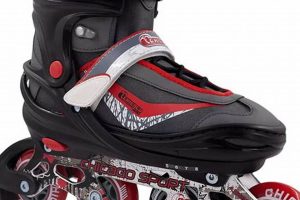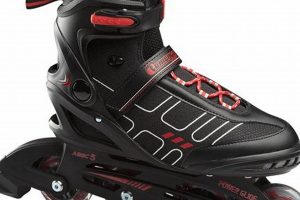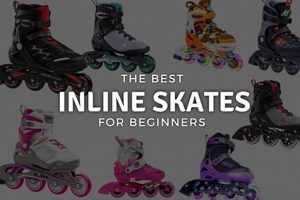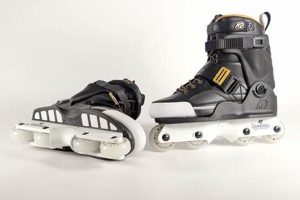Inline skates designed with a broader boot and frame configuration offer increased stability and comfort. These skates accommodate individuals with wider feet or those seeking a more forgiving fit compared to standard inline skate models. An example would be a skate designed specifically to prevent pressure points on the sides of the foot, allowing for extended use without discomfort.
The significance of these skates lies in their enhanced accessibility and improved skating experience for a wider range of users. Benefits include reduced foot fatigue, increased control due to a more secure fit, and the potential to mitigate or prevent common skating-related foot problems. Historically, skate manufacturers have expanded their offerings to include wider models in response to consumer demand for improved comfort and performance.
The following sections will explore specific aspects of these skates, including design variations, ideal user profiles, factors to consider when selecting a suitable pair, and maintenance tips for optimal performance and longevity.
Tips for Selecting Appropriate Inline Skates
Selecting inline skates requires careful consideration to ensure both comfort and performance. Factors such as foot width, skating style, and intended usage play crucial roles in the decision-making process.
Tip 1: Measure Foot Width Accurately: Utilize a Brannock device or a similar measuring tool to determine precise foot width. This measurement serves as a baseline for comparing skate specifications.
Tip 2: Consider Boot Volume: Beyond width, foot volume influences fit. Individuals with high insteps may require skates with adjustable closures or higher boot profiles to accommodate the increased volume.
Tip 3: Examine Frame Width and Length: A wider frame enhances stability, particularly beneficial for beginners. However, experienced skaters might prefer a narrower frame for increased maneuverability.
Tip 4: Inspect Liner Padding: Adequate padding in the liner minimizes pressure points and improves overall comfort. Look for liners constructed from heat-moldable materials for a customized fit.
Tip 5: Evaluate Closure Systems: Closure systems, including buckles, laces, and power straps, contribute to securing the foot within the skate. Ensure the system provides adequate support and adjustability.
Tip 6: Test Before Purchase When Possible: Whenever feasible, try on skates with appropriate socks and simulate skating motions to assess comfort and fit. Pay attention to potential areas of discomfort or pressure.
Tip 7: Research Skate Specifications: Prior to purchase, thoroughly research skate specifications, including width, frame material, bearing quality, and wheel durometer, to ensure compatibility with intended use and skill level.
Implementing these selection strategies will significantly improve the likelihood of finding inline skates that offer optimal comfort, performance, and long-term satisfaction.
The subsequent section will address maintenance procedures crucial for preserving skate integrity and prolonging their lifespan.
1. Foot Width
Foot width is a critical determinant in selecting inline skates that provide both comfort and optimal performance. Standard inline skates are often designed with a narrow footbed, potentially leading to discomfort or injury for individuals with wider feet. Therefore, understanding the nuances of foot width and its impact on skate fit is paramount when considering models designed for broader feet.
- Measurement Protocols
Accurate foot width measurement is essential. Utilizing a Brannock device or a similar calibrated instrument provides a standardized measurement that can be compared to skate manufacturer specifications. Inaccurate measurements can result in the purchase of skates that are either too tight, restricting circulation and causing discomfort, or too loose, compromising stability and control.
- Implications of Constriction
Inadequate width in inline skates can lead to various foot ailments, including blisters, bunions, and nerve compression. Prolonged constriction can also exacerbate pre-existing conditions. Skates designed to accommodate wider feet alleviate these concerns by providing ample space for natural foot splay during skating.
- Impact on Performance
Foot width directly influences skating performance. Overly narrow skates can impede proper foot alignment, reducing power transfer and control. Conversely, skates that adequately accommodate foot width promote a more stable and efficient skating stride, enabling greater agility and responsiveness.
- Design Adaptations
Manufacturers address the issue of foot width through various design adaptations. These include wider boot shells, expandable liners, and adjustable closure systems. Some skates also feature heat-moldable liners that conform to the individual’s foot shape, providing a customized fit that further enhances comfort and performance.
The correlation between foot width and the design of wider inline skates is undeniable. Prioritizing accurate foot measurement and selecting skates that specifically address the needs of wider feet is crucial for ensuring a comfortable, safe, and efficient skating experience. Ignoring this connection can lead to discomfort, injury, and suboptimal performance.
2. Boot Volume
Boot volume, referring to the internal three-dimensional space within the skate boot, is a crucial factor that complements foot width considerations in the context of appropriately fitted inline skates. It dictates the vertical space available for the foot, impacting comfort and performance, particularly for individuals requiring wider models.
- Instep Height Accommodation
Instep height, the distance from the top of the foot to the sole, significantly influences boot volume requirements. Individuals with high insteps may find standard inline skates constricting, leading to discomfort and reduced circulation. Inline skates with increased volume in the instep area offer a more comfortable and secure fit. This is often achieved through modifications to the boot’s shell design or the incorporation of adjustable closure systems specifically designed to accommodate higher insteps.
- Ankle Circumference and Support
The circumference of the ankle also contributes to the overall boot volume requirement. Skates offering adjustable ankle cuffs or liners with enhanced padding in the ankle region allow for a customized fit that supports the ankle without restricting movement. This is particularly important for skaters seeking stability and control, as a secure ankle fit prevents excessive movement within the boot, reducing the risk of injury.
- Liner Thickness and Density
The thickness and density of the skate liner significantly impact internal boot volume. Thicker liners provide increased cushioning and insulation, but they also reduce the available space within the boot. Conversely, thinner liners offer more room but may compromise comfort and support. When selecting skates, especially those with wider designs, it is crucial to consider the liner’s properties and how they affect the overall fit and feel of the skate. Heat-moldable liners can provide a customized fit, optimizing both comfort and performance within the constraints of the boot’s volume.
- Compatibility with Orthotics
Individuals requiring orthotics or custom footbeds need to account for the additional volume these inserts occupy within the skate boot. Skates with removable liners or adjustable footbeds provide greater flexibility in accommodating orthotics. The overall boot volume must be sufficient to accommodate both the foot and the orthotic without compromising comfort or proper foot alignment.
The interplay between foot width and boot volume is critical in achieving an optimal fit for inline skates. While wider models address horizontal space requirements, sufficient boot volume ensures that vertical dimensions are also adequately addressed. Ignoring either aspect can lead to discomfort, reduced performance, and an increased risk of injury. Therefore, a comprehensive assessment of both foot width and boot volume is essential when selecting inline skates.
3. Frame Stability
Frame stability, a crucial component of inline skate design, exhibits a direct relationship with the performance and user experience of models designed for wider feet. A stable frame minimizes unwanted flex and torsional movement during skating, translating to improved control, efficient power transfer, and reduced risk of ankle strain. In the context of wider inline skates, frame stability becomes even more critical due to the potentially increased leverage exerted by a wider foot and the corresponding shift in the skater’s center of gravity. For example, a skater with wider feet using a narrow, flexible frame may experience increased difficulty maintaining a straight line or executing precise turns, especially at higher speeds. The practical significance of this understanding lies in the enhanced safety and control afforded by a stable frame, contributing to a more enjoyable and confidence-inspiring skating experience.
The materials and construction techniques employed in frame manufacturing directly impact its overall stability. Frames constructed from stiffer materials, such as extruded aluminum, generally exhibit greater resistance to flexing compared to those made from composite materials or lower-grade alloys. Additionally, frame design features, such as reinforced sidewalls and cross-bracing, contribute to enhanced torsional rigidity. In practice, skaters who prioritize stability, particularly those with wider feet or those engaging in aggressive skating styles, should seek models with frames constructed from robust materials and incorporating design elements that maximize stiffness. This consideration is particularly important for larger individuals, where their weight amplifies the forces acting upon the frame, making a stable design imperative.
In summary, frame stability is inextricably linked to the performance and safety of inline skates, especially those designed for wider feet. A stable frame provides a solid platform for power transfer, enhances control, and minimizes the risk of ankle strain. The choice of frame material, design features, and overall construction plays a pivotal role in determining frame stability. By carefully considering these factors, skaters can select wider inline skate models that offer the necessary support and stability for a confident and enjoyable skating experience. While technological advancements continue to refine frame designs, the fundamental principle remains: a stable frame is essential for optimal performance and safety.
4. Liner Padding
Liner padding within inline skates is a critical determinant of comfort, fit, and performance, particularly in skates designed for wider feet. Adequate and well-placed padding mitigates pressure points, enhances stability, and contributes to overall foot support, thereby impacting the skating experience.
- Pressure Distribution and Comfort
Liner padding serves as a cushion between the foot and the rigid shell of the inline skate. In wider skates, this is especially important as the foot may have more contact area with the boot. Insufficient or poorly distributed padding can lead to localized pressure points, causing discomfort, blisters, or even nerve compression. Effective padding utilizes multi-density foams to distribute pressure evenly across the foot, minimizing discomfort and promoting longer, more enjoyable skating sessions.
- Ankle and Heel Support
The ankle and heel regions require specialized padding to ensure secure foot placement and prevent slippage within the skate. In wide inline skates, the increased volume around the foot can potentially exacerbate heel lift or ankle movement. Strategically placed, high-density padding in these areas enhances stability, promotes efficient power transfer, and reduces the risk of ankle sprains or other injuries. The effectiveness of this support is directly linked to the skater’s ability to maintain control and execute maneuvers with precision.
- Moisture Management and Breathability
Liner padding materials influence moisture management and breathability within the skate. Prolonged skating generates heat and sweat, which can accumulate within the boot, leading to discomfort and potential skin irritation. Advanced liner materials, such as those incorporating moisture-wicking fabrics and ventilation channels, promote airflow and dissipate moisture, keeping the foot dry and comfortable. This is especially important for skaters with wider feet, as the increased contact area can amplify sweat production.
- Customization and Fit Adjustments
Certain liner padding materials offer customization options, such as heat molding, allowing the liner to conform to the unique contours of the individual’s foot. This is particularly beneficial for individuals with wide feet, as it enables a more precise and comfortable fit. Customizable padding can address specific pressure points or areas of discomfort, further enhancing the overall skating experience and optimizing performance. These technologies allow skaters to achieve a near-bespoke fit, maximizing comfort and minimizing the potential for issues arising from ill-fitting skates.
The significance of liner padding in wider inline skates extends beyond mere comfort. It plays a critical role in ensuring proper foot support, stability, and moisture management, ultimately impacting the skater’s performance and enjoyment. Selection of skates with high-quality, strategically designed padding is therefore essential for individuals seeking a comfortable and efficient skating experience.
5. Closure System
The closure system on inline skates is intrinsically linked to the fit and performance, particularly for models accommodating wider feet. The effectiveness of the closure system directly impacts how securely and comfortably the foot is held within the boot. A poorly designed or implemented closure can negate the benefits of a wider skate, leading to discomfort, instability, and reduced control. For example, a skate designed for wider feet but featuring a single, flimsy buckle may fail to provide sufficient support across the instep, allowing the foot to shift during use. The practical significance lies in the need for a robust and adjustable closure mechanism that can accommodate the unique contours of a wider foot, ensuring a snug and secure fit without excessive pressure points.
Various closure systems exist, each offering different advantages and disadvantages for wider inline skates. Laces provide a high degree of adjustability across the entire foot, allowing for a customized fit that can accommodate variations in foot volume and shape. Buckles offer quick and easy adjustment, but may not provide the same level of precision as laces. Power straps, typically positioned across the instep, enhance ankle support and prevent heel lift, crucial for maintaining control and stability. Hybrid systems, combining laces, buckles, and power straps, often represent the most effective solution, providing a balance of adjustability, security, and convenience. The choice of closure system should be dictated by individual preferences and the specific needs of the skater’s foot.
In summary, the closure system is an integral component of wide inline skates, directly influencing fit, comfort, and performance. A well-designed closure ensures that the foot is securely and comfortably held within the boot, maximizing control and minimizing the risk of discomfort or injury. The selection of an appropriate closure system, whether it be laces, buckles, power straps, or a hybrid approach, is paramount to realizing the full potential of wider inline skates. Challenges remain in developing closure systems that offer both precise adjustability and ease of use, but ongoing innovations in materials and design promise to further enhance the performance and comfort of these critical components.
6. Wheel Durometer
Wheel durometer, a measurement of a wheel’s hardness, plays a significant role in the performance and feel of inline skates, particularly those designed for wider feet. The durometer value, typically expressed on the A scale, indicates the wheel’s resistance to indentation. Understanding its implications is crucial for optimizing the skating experience.
- Grip and Control
Softer wheels (lower durometer values) generally offer enhanced grip on various surfaces. This is particularly beneficial for skaters using wider inline skates, as the increased foot surface area and potential for higher weight distribution can necessitate greater traction for maintaining control. For example, a skater with wider feet using 78A durometer wheels on asphalt would experience more grip than with 85A wheels, especially during turns or when skating on slightly uneven surfaces.
- Speed and Roll
Harder wheels (higher durometer values) tend to roll faster and maintain momentum more effectively on smooth surfaces. However, this comes at the expense of grip. While skaters with wider inline skates may benefit from the increased speed of harder wheels on perfectly smooth surfaces, the trade-off in grip should be carefully considered, especially in environments where sudden stops or sharp turns are required. A speed skater on a banked track might opt for 88A wheels, but a recreational skater on mixed terrain would likely prefer something softer.
- Wear and Durability
Wheel durometer directly impacts wear and durability. Softer wheels wear down more quickly, especially on abrasive surfaces, while harder wheels offer greater resistance to wear. Skaters using wider inline skates should consider the trade-off between grip and durability based on their typical skating environment and usage frequency. A skater primarily skating on rough concrete would likely find that harder wheels, despite offering less grip, last significantly longer than softer options.
- Shock Absorption and Comfort
Softer wheels provide better shock absorption, contributing to a smoother and more comfortable ride, particularly on uneven surfaces. This is especially relevant for skaters with wider inline skates, as the wider platform may transmit more vibrations directly to the foot. The improved shock absorption of softer wheels can help mitigate this effect, reducing fatigue and enhancing overall comfort. A skater using wider skates on a brick pathway would experience significantly less vibration with softer wheels.
In conclusion, wheel durometer is a critical consideration for skaters using wider inline skates. The optimal durometer depends on a balance of factors, including the skating environment, desired speed, and the skater’s priorities in terms of grip, durability, and comfort. Careful selection based on these factors can significantly enhance the overall skating experience.
Frequently Asked Questions
The following questions address common inquiries regarding inline skates designed to accommodate wider feet. The information presented is intended to provide clarity and inform purchasing decisions.
Question 1: What distinguishes wide inline skates from standard models?
Wide inline skates feature a boot and chassis design with increased internal volume and width to comfortably accommodate individuals with broader feet. Standard models are typically narrower and may cause discomfort or restricted circulation for such users.
Question 2: Are wide inline skates suitable for all skill levels?
Yes, wide inline skates are suitable for skaters of all skill levels. Beginners often benefit from the added stability provided by the wider platform, while experienced skaters can appreciate the enhanced comfort during extended use.
Question 3: How does foot width impact skate performance?
Foot width directly affects skate performance. If a skate is too narrow, it can restrict foot movement, reduce power transfer, and cause discomfort. Wide inline skates allow for natural foot splay, promoting efficient skating technique and reducing fatigue.
Question 4: What are the potential benefits of using wide inline skates?
Potential benefits include improved comfort, reduced foot pain, enhanced stability, and increased control. These skates are designed to minimize pressure points and accommodate the natural shape of a wider foot, leading to a more enjoyable skating experience.
Question 5: Are specialized socks necessary when using wide inline skates?
While not strictly necessary, utilizing thin, moisture-wicking socks designed for skating can further enhance comfort and prevent friction within the boot. Thick socks should generally be avoided, as they can compromise the fit and reduce breathability.
Question 6: How should wide inline skates be maintained?
Maintenance procedures for wide inline skates are similar to those for standard models. Regularly clean the wheels and bearings, inspect the frame for damage, and ensure the closure system is functioning correctly. Promptly address any signs of wear or damage to prolong the lifespan of the skates.
Selecting the appropriate inline skate requires careful consideration of individual foot dimensions and skating style. Wide inline skates offer a viable solution for those seeking enhanced comfort and performance.
The following section will provide a summary of the essential considerations outlined in this article.
Conclusion
This article has comprehensively explored the characteristics, benefits, selection criteria, and maintenance of inline skates designed for wider feet. Key points emphasized include the importance of accurate foot measurement, consideration of boot volume, the role of frame stability, the impact of liner padding, the influence of closure systems, and the selection of appropriate wheel durometer. Addressing these factors contributes to a more comfortable, efficient, and safer skating experience for a broader range of users.
The continued development and refinement of specialized inline skate designs, such as wide inline skates, underscores the industry’s commitment to accommodating diverse user needs. It is incumbent upon prospective purchasers to critically evaluate individual requirements and prioritize the selection of equipment that aligns with both physical characteristics and intended usage patterns, therefore maximizing the potential for sustained engagement and enjoyment of the sport.






![Shop Barbie Inline Skates - [Year] Best Deals! Safem Fabrication - Precision Engineering & Custom Manufacturing Solutions Shop Barbie Inline Skates - [Year] Best Deals! | Safem Fabrication - Precision Engineering & Custom Manufacturing Solutions](https://cruzskateshop.com/wp-content/uploads/2025/06/th-3409-300x200.jpg)
